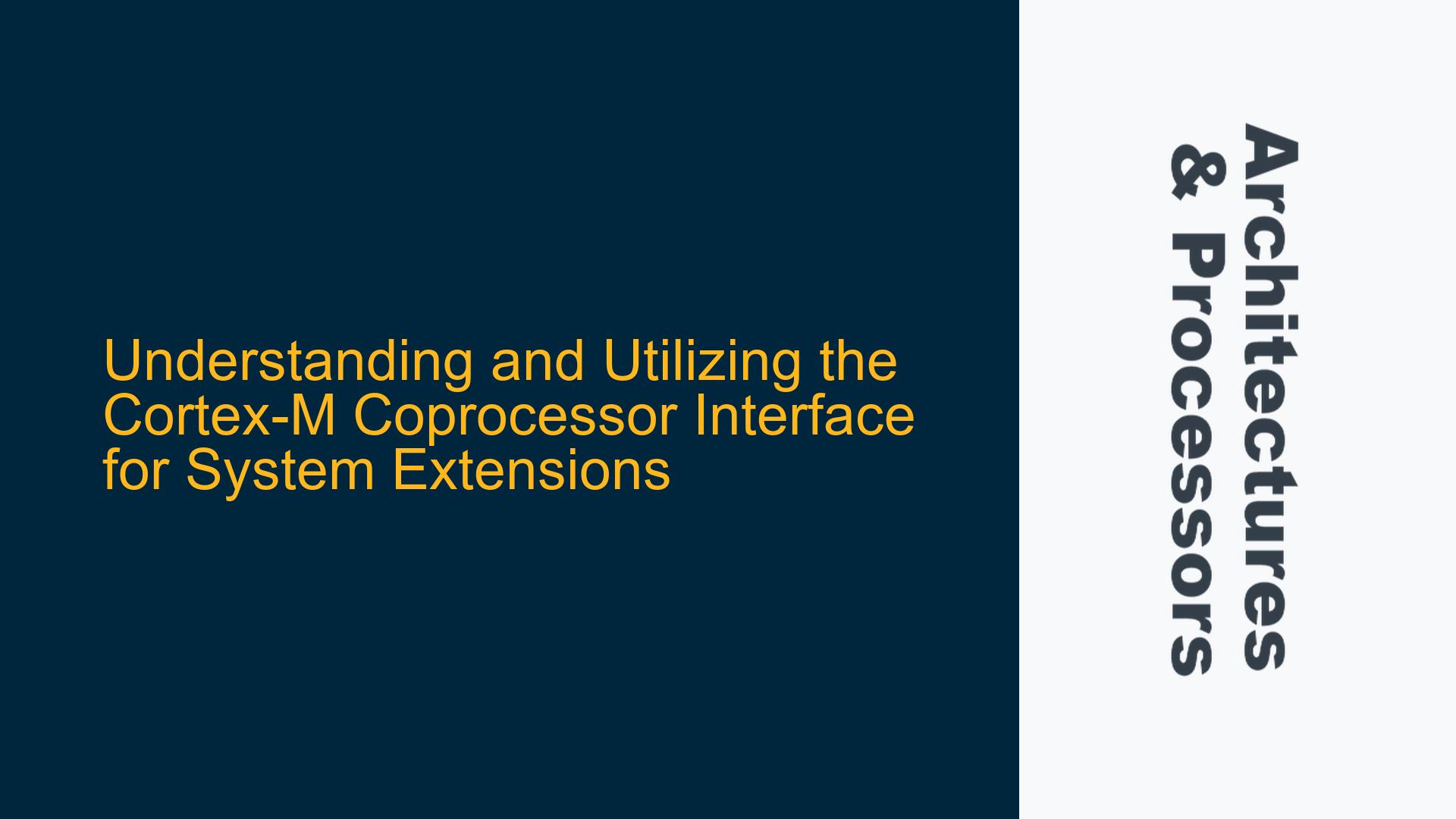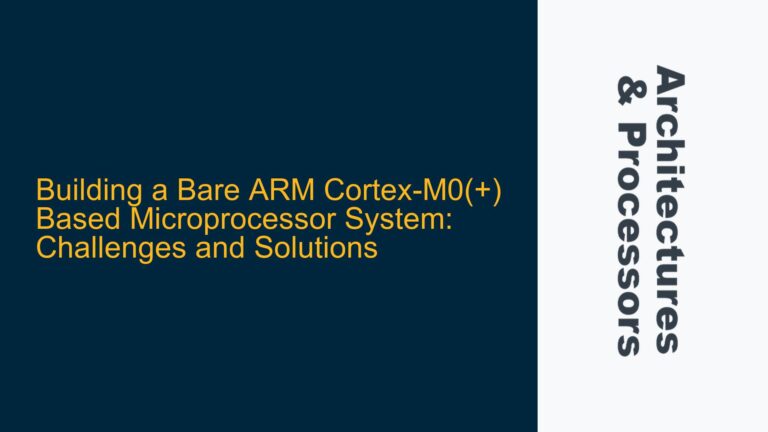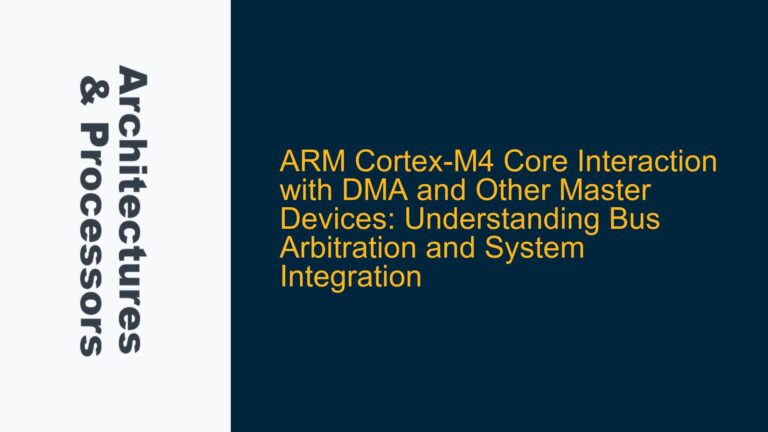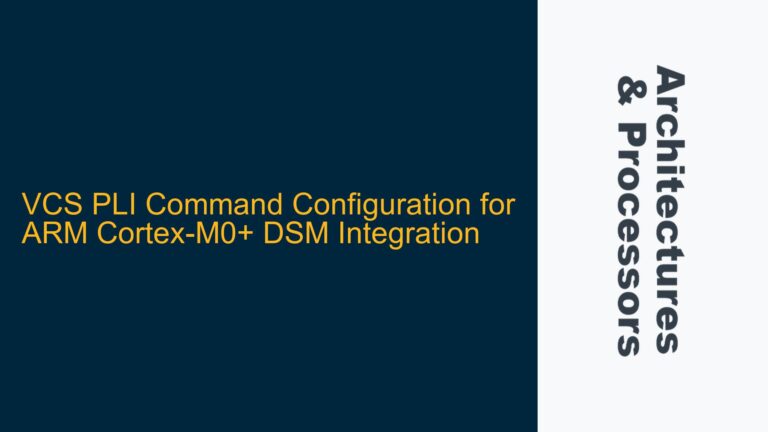Cortex-M Coprocessor Interface: Purpose and Limitations in Modern Embedded Systems
The Cortex-M series of processors, widely used in embedded systems, includes a coprocessor interface designed to extend the functionality of the core processor. This interface allows for the integration of specialized hardware accelerators or additional processing units that can offload specific tasks from the main CPU, thereby enhancing performance for particular applications. However, the utility and implementation of this interface are often misunderstood, especially in the context of modern system design where alternative approaches like memory-mapped peripherals or dedicated accelerators are more common.
The coprocessor interface in Cortex-M processors is not a general-purpose communication channel between different processors, such as between a Cortex-M and a Cortex-A or Cortex-R core. Instead, it is a tightly coupled interface intended for extending the instruction set and computational capabilities of the Cortex-M core itself. This distinction is critical for system designers who might consider using the coprocessor interface for inter-processor communication, as it is not designed for this purpose.
Historically, coprocessors were used to accelerate specific operations, such as floating-point calculations, digital signal processing (DSP), or cryptographic functions. However, advancements in system design have reduced the need for dedicated coprocessors in many applications. Modern Cortex-M processors often integrate these functionalities directly into the core or provide them as memory-mapped peripherals, which are easier to implement and manage.
The coprocessor interface is not universally supported across all Cortex-M processors. For example, the Cortex-M0 and Cortex-M0+ cores do not include this interface, while it is available in higher-end cores like the Cortex-M4 and Cortex-M7. This variability means that designers must carefully consider their target processor and whether the coprocessor interface is a viable option for their specific use case.
In summary, the Cortex-M coprocessor interface is a specialized feature for extending the core’s capabilities, but its relevance has diminished in modern embedded systems due to the availability of more flexible and efficient alternatives. Understanding its purpose and limitations is essential for making informed design decisions.
Memory-Mapped Peripherals vs. Coprocessor Interface: Design Trade-offs and Implementation Challenges
When considering the use of the Cortex-M coprocessor interface, it is important to weigh the design trade-offs against alternative approaches, particularly memory-mapped peripherals. Memory-mapped peripherals are a common method for extending processor functionality, where additional hardware blocks are accessed through the processor’s memory bus. This approach offers several advantages over the coprocessor interface, including simplicity, flexibility, and compatibility with a wider range of processors.
Memory-mapped peripherals are easier to implement because they do not require the tight coupling and specialized interface logic needed for coprocessors. They can be designed as standard hardware blocks that communicate with the processor through read and write operations to specific memory addresses. This makes them accessible to any processor with a memory bus, regardless of whether it supports a coprocessor interface.
In contrast, the coprocessor interface requires a more complex design, as it involves extending the processor’s instruction set and integrating the coprocessor into the core’s pipeline. This tight coupling can provide performance benefits for specific tasks, but it also introduces additional design complexity and limits the portability of the solution. For example, a coprocessor designed for a Cortex-M4 processor would not be compatible with a Cortex-M0+ processor, whereas a memory-mapped peripheral could be used with both.
Another challenge with the coprocessor interface is the lack of available IP blocks from ARM or third-party vendors. Unlike memory-mapped peripherals, which are widely available and supported by a large ecosystem of tools and libraries, coprocessors are typically custom-designed for specific applications. This means that designers who wish to use the coprocessor interface must develop their own IP, which can be a significant undertaking.
Despite these challenges, there are scenarios where the coprocessor interface may still be the best option. For applications that require extremely low latency or high throughput for specific operations, the tight coupling of a coprocessor can provide performance benefits that outweigh the design complexity. Additionally, the coprocessor interface can be used to implement custom instructions that are not supported by the core processor, enabling optimizations for specialized algorithms.
In conclusion, the choice between memory-mapped peripherals and the coprocessor interface depends on the specific requirements of the application. Memory-mapped peripherals offer a simpler and more flexible solution for most use cases, while the coprocessor interface may be justified for applications that require the highest performance for specific tasks.
Designing Custom Coprocessors for Cortex-M: Best Practices and Optimization Strategies
For designers who choose to implement a custom coprocessor using the Cortex-M coprocessor interface, there are several best practices and optimization strategies that can help ensure a successful implementation. These include careful planning of the coprocessor’s functionality, efficient integration with the core processor, and thorough testing and validation.
The first step in designing a custom coprocessor is to clearly define its functionality and the specific tasks it will offload from the core processor. This requires a detailed analysis of the application’s performance bottlenecks and the identification of operations that can benefit from hardware acceleration. For example, a coprocessor might be designed to accelerate cryptographic algorithms, DSP functions, or complex mathematical operations.
Once the functionality of the coprocessor has been defined, the next step is to design the interface between the coprocessor and the core processor. This involves extending the processor’s instruction set to include new instructions that will be executed by the coprocessor. These instructions must be carefully designed to ensure that they integrate seamlessly with the core’s pipeline and do not introduce unnecessary overhead.
Efficient integration with the core processor also requires careful consideration of the coprocessor’s timing and synchronization. The coprocessor must be able to execute its tasks without stalling the core processor, and it must be able to handle interrupts and other exceptions gracefully. This may require the use of additional control signals or status registers to coordinate the activities of the core and coprocessor.
Thorough testing and validation are critical to ensuring the reliability and performance of the custom coprocessor. This includes both functional testing to verify that the coprocessor performs its intended tasks correctly, and performance testing to measure the impact on the overall system. It is also important to test the coprocessor under a variety of conditions, including different workloads and operating environments, to ensure that it behaves as expected in all scenarios.
In addition to these best practices, there are several optimization strategies that can be employed to maximize the performance of the custom coprocessor. These include minimizing the latency of coprocessor operations, optimizing the data flow between the core and coprocessor, and leveraging parallelism to execute multiple operations simultaneously. For example, a coprocessor designed for DSP applications might use pipelining to process multiple data samples in parallel, or it might use specialized hardware to perform complex mathematical operations in a single cycle.
Another important optimization strategy is to minimize the power consumption of the coprocessor, especially in battery-powered or energy-constrained applications. This can be achieved through careful design of the coprocessor’s logic and the use of power-saving techniques such as clock gating or dynamic voltage and frequency scaling (DVFS).
In conclusion, designing a custom coprocessor for the Cortex-M series requires careful planning, efficient integration, and thorough testing. By following best practices and employing optimization strategies, designers can create coprocessors that provide significant performance benefits for their specific applications. However, it is important to weigh these benefits against the design complexity and consider whether alternative approaches, such as memory-mapped peripherals, might be more appropriate for the given use case.
This post provides a comprehensive overview of the Cortex-M coprocessor interface, its purpose, limitations, and practical considerations for its use in modern embedded systems. By understanding the trade-offs between the coprocessor interface and alternative approaches, and by following best practices for designing custom coprocessors, system designers can make informed decisions that optimize the performance and efficiency of their embedded applications.






